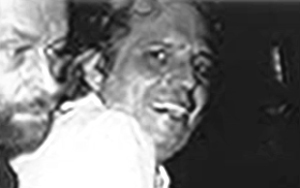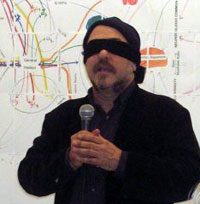Related Research Articles

The Hammer Museum, which is affiliated with the University of California, Los Angeles, is an art museum and cultural center known for its artist-centric and progressive array of exhibitions and public programs. Founded in 1990 by the entrepreneur-industrialist Armand Hammer to house his personal art collection, the museum has since expanded its scope to become "the hippest and most culturally relevant institution in town." Particularly important among the museum's critically acclaimed exhibitions are presentations of both historically overlooked and emerging contemporary artists. The Hammer Museum also hosts over 300 programs throughout the year, from lectures, symposia, and readings to concerts and film screenings. As of February 2014, the museum's collections, exhibitions, and programs are completely free to all visitors.

Otis College of Art and Design is a private art and design school in Los Angeles, California, United States. Established in 1918, it was the city's first independent professional school of art. The main campus is located in the former IBM Aerospace headquarters at 9045 Lincoln Boulevard in Westchester, Los Angeles. The school's programs, accredited by the WSCUC and National Association of Schools of Art and Design, include BFA and MFA degrees.

KKSF is a commercial AM radio station licensed to Oakland, California and serving the San Francisco Bay Area. The station is owned by iHeartMedia and has an all-news radio format, with programming from the co-owned Black Information Network (BIN). The studios are located on Townsend Street in San Francisco's SoMa district.

Martin Kippenberger was a German artist known for his extremely prolific output in a wide range of styles and media, superfiction as well as his provocative, jocular and hard-drinking public persona.

Lisa Adams is an American painter who emerged in the mid-1980s. She is best known for her oil paintings of imaginary worlds that address both personal and collective realities. Her work has been exhibited nationally and internationally and is in the public collections of LACMA, Eli Broad, the San Jose Museum of Art, the USC Fisher Museum of Art, the Long Beach Museum of Art, the Edward F. Albee Foundation, the Frederick R. Weisman Museum and the Laguna Museum of Art. She lives and works in downtown Los Angeles, California.

Floyd E. Norman is an American animator, writer, and cartoonist. Over the course of his career, he has worked for various animation companies, among them Walt Disney Animation Studios, Hanna-Barbera Productions, Ruby-Spears, Film Roman and Pixar.

Bjørn Melhus is a German artist of Norwegian ancestry known for experimental short films, videos and installations.

Doug Aitken is an American multidisciplinary artist. Aitken's body of work ranges from photography, print media, sculpture, and architectural interventions, to narrative films, sound, single and multi-channel video works, installations, and live performance. He currently lives in Venice, California, and New York City.
Camille Utterback is an interactive installation artist. Initially trained as a painter, her work is at the intersection of painting and interactive art. One of her most well-known installations is the work Text Rain (1999).
Bruce Yonemoto and Norman Yonemoto are two Los Angeles, California-based video/installation artists of Japanese American heritage.

Scott Kildall is an American conceptual artist working with new technologies in a variety of media including video art, prints, sculpture and performance art. Kildall works broadly with virtual worlds and in the net.art movement. His work centers on repurposing technology and repackaging information from the public realm into art. He often invites others to participate in the work.
Robert Akira Nakamura is a filmmaker and teacher, sometimes referred to as "the Godfather of Asian American media." In 1970 he cofounded Visual Communications (VC) the oldest community-based Asian Pacific American media arts organization in the United States.

Warren Neidich is an American artist who lives in Berlin and Los Angeles. He was a professor at Kunsthochschule Weißensee School of Art, Berlin and visiting scholar at Otis College of Art and Design, Los Angeles.

Josh Kun is an American author, academic and music critic. Kun is Professor of Communication and Journalism and chair in Cross-Cultural Communication in the Annenberg School at the University of Southern California. He also holds a joint appointment at USC's Department of American Studies and Ethnicity. He is the director of USC Annenberg's School of Communication, director of the Popular Music Project at USC Annenberg's the Norman Lear Center and co-editor of the book series Refiguring American Music for Duke University Press.

Benjamin H. Bratton is an American Philosopher of Technology known for his work spanning social theory, computer science, design, artificial intelligence, and for his writing on the geopolitical implications of what he terms "planetary scale computation".
Jan Wurm is an American painter, educator and curator. Her work comes out of a figurative tradition rooted in social commentary. Wurm draws on a combination of modern German, Austrian, and American aesthetics to depict human interactions and daily life.

The Imaginary 20th Century is a historical comic novel written by Norman M. Klein in collaboration with Gilded Age historian Margo Bistis. It is available in print (2016) and as an e-book with a companion narrated media archive (2014). The novel originated as an interactive archive with related solo and group exhibitions prior to publication. In 2012, Klein and Bistis coined the term "wunder-roman" to describe their alternative genre. As described in the novel, this term references a mythical 19th-century version of the picaresque novel where the layers—as story roll along a water wheel.

Emma Pérez is an American author and professor, known for her work in queer Chicana feminist studies.

The MAK Center for Art and Architecture is an art museum and cultural center headquartered in the Schindler House in West Hollywood, California, United States. It is affiliated with the Museum of Applied Arts, Vienna (MAK). The Center is situated in three architectural landmarks, designed by Austrian-American architect R.M. Schindler. The center operates a residency program and exhibition space at the Mackey Apartments and runs residencies and a study center at the Fitzpatrick-Leland House.
Elizabeth Armstrong is an American curator of contemporary and modern art. Beginning in the late 1980s, she served in chief curatorial and leadership roles at the Walker Art Center, Museum of Contemporary Art, San Diego, Orange County Museum of Art (OCMA), Minneapolis Institute of Arts and Palm Springs Art Museum. She has organized numerous touring exhibitions and catalogues that gained national and international attention; among the best known are: "In the Spirit of Fluxus", "Ultrabaroque: Aspects of Post-Latin American Art", and "Birth of the Cool: California Art, Design, and Culture at Midcentury". She is also known for organizing three California Biennials (2002–6) and notable exhibitions of David Reed and Mary Heilmann. Armstrong's curatorial work and publications have been recognized by the Andy Warhol Foundation, the Center for Curatorial Leadership, the Getty Foundation Pacific Standard Time project and the National Endowment for the Arts, among other organizations.
References
- ↑ "Norman M. Klein — internationales literaturfestival berlin". Archived from the original on 2021-09-18. Retrieved 2021-02-06.
- ↑ Ben Ehrenreich. "Old Haunts Revisited."The Los Angeles Times. July 2, 2006.
- ↑ Christopher Reynolds. "The Best L.A. Books? Let's Make a List (Part 2, nonfiction)."The Los Angeles Times. October 4, 2011.
- ↑ Interview with Hans-Ulrich Obrist. 2015.
- ↑ "Norman Klein - Faculty/Staff Directory". Directory.calarts.edu. Archived from the original on 2015-09-10. Retrieved 2016-07-17.
- ↑ "Mapping the Unfindable | Beall Center for Art + Technology". beallcenter.uci.edu. Archived from the original on 2023-12-01. Retrieved 2024-02-22.
- ↑ Michael Ned Holte. "Urban Legends: Michael Ned Holte on Norman M. Klein's Tales of the Floating Class". Artforum. May 2019. p 55
- ↑ The Imaginary 20th Century. Karlsruhe. KZM Center for Art & Media. 2016.
- ↑ Freud in Coney Island and Other Tales. Los Angeles. Otis Books/Seismicity Editions. 2006.
- ↑ The Vatican to Vegas: The History of Special Effects . New York. New Press. 2004.
- ↑ Bleeding Through: Layers of Los Angeles, 1920-1986. Karlsruhe. Annenberg Center for Communication; Los Angeles. and KZM Center for Art and Media. 2003.
- ↑ "2004 - SPLIT FILM FESTIVAL - MFNF". Splitfilmfestival.hr. Archived from the original on 2016-11-13. Retrieved 2016-11-23.
- ↑ "[transmediale] transmediale.04 award nominations". Mailman.transmediale.in-berlin.de. Archived from the original on 2016-08-07. Retrieved 2016-11-23.
- ↑ The History of Forgetting: Los Angeles and the Erasure of Memory. London. Verso. 1997. Revised edition 2008
- ↑ 7 Minutes: The Life and Death of the American Animated Cartoon. London. Verso. 1993.
- ↑ Twentieth-Century Art Theory. Co-edited with Richard Hertz. Upper Saddle River. Prentice-Hall. 1990.
- ↑ Twentieth Century Los Angeles: Power, Promotion, and Social Conflict . Co-edited with Martin Schiesl. New York. Regina. 1990.
- ↑ "A Granular History of Space: Doug Aitken."Doug Aitken: Electric Earth. Los Angeles. Museum of Contemporary Art. 2016.
- ↑ "A Revised History of the Screen in Three Stages." Chip Lord. College Park. The University of Maryland. 2015.
- ↑ "Whole Earths, 1968-1980." The Whole Earth: California and the Disappearance of the Outside . Berlin. Haus der Kulturen der Welt. 2013.
- ↑ "The Charm of the Lie." More Real? Art in the Age of Truthiness. Minneapolis. Minneapolis Institute of Art. 2012.
- ↑ "The Ironies of Global Video, 1973-2000." Exchange and Evolution: Worldwide Video Long Beach 1974-1999. Long Beach. Long Beach Museum of Art. 2012.
- ↑ "Suburban Ruin: Notes on the Dismantling of the American Psyche." Cruise Line. Aachen. Neuer Aachener Kunstverein. 2011
- ↑ "Paradises." Kutluğ Ataman: Paradise. Newport Harbor. Orange County Museum of Art. 2007.
- ↑ "Cinematic Photography and the Misremembering of the City." Karina Nimmerfall: Cinematic Maps, 2004-2006. Graz. Camera Austria. 2007.
- ↑ "Historical Paintings of the Global Present."Night of the Palomino. Los Angeles. Honor Fraser Inc. 2007.
- ↑ "Grounding Play: Imaginary Children in An Era of Global Paranoia." Peter Friedl: Theory of Justice 1964-2006. Barcelona. MACBA. 2006.
- ↑ "A Spot in Time: Christian Jankowski's Startling Special Effect." Everything Fell Together. Des Moines. Des Moines Art Center. 2006.
- ↑ "How to Irrigate Your Personality: The Hollowing Out of America." Bjørn Melhus: Auto Center Drive. Stuttgart. Hatje Cantz. 2005.
- ↑ "Fault Lines: The Machines of George Stone." George Stone: Probabilities. Los Angeles. Los Angeles Municipal Art Gallery. 2003.
- ↑ "Vegaesthetics." The Magic Hour: The Convergence of Art and Las Vegas. Graz. Neue Galerie. 2001.
- ↑ "Animations: Painting with a Machine Gun." Animations. Long Island City. MoMA/PS1. 2001.
- ↑ "Architainment, The Industrialization of Desire, 1955-2010." Au-Delà du Spectacle. Paris. Centre Pompidou. 2000.
- ↑ "Gold Fevers: Global California and the Social Imaginary." Reading California: Art, Image, and Identity, 1900-2000. Los Angeles. Los Angeles County Art Museum. 2000.
- ↑ "Kippenberger's Folies." Martin Kippenberger: The Last Stop West. Stuttgart. Hatje Cantz. 1999.
- ↑ "Consumer-Built City: Sixty Years of Apocalyptic Imagery." Helter Skelter: L.A. Art in the 1990s. Los Angeles. Museum of Contemporary Art. 1992.
- ↑ Erasure: The Spectre of Memory. John Conomos (ed.). London. Libri. 2015.
- ↑ Architecture and the Worker. Peggy Deamer (ed.). London. Bloomsbury. 2015.
- ↑ Third Person: Authoring and Exploring Vast Narratives. Pat Harrigan and Noah Wardrip-Fruin (eds.). Cambridge. MIT Press. 2009.
- ↑ Iconoclash. Bruno Latour (ed.).Cambridge. MIT Press. 2002.